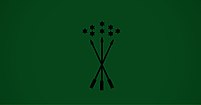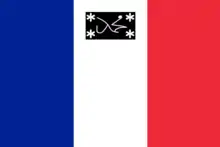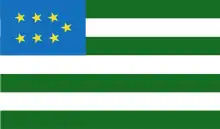Circassian flag
The Circassian flag or the flag of the Republic of Adygea, is a flag consisting of a green field charged with twelve gold stars, nine forming an arc and three horizontal. It is also charged with three crossed arrows in the center. The green color rgb values (41 105 18), and the gold colors rgb values (253 252 2). The Scot David Urquhart (1805-1877), then serving on the staff of the British Embassy in Constantinople, designed the prototype in 1836,[1][2] taking inspiration from early Circassian symbols advocated by regional leaders who tried to unify Circassia in the past such as Qalawebateqo Shuwpagwe, and the modern design was finalised by Sefer Bey Zanuqo.
 | |
| Name | The Green-Golden banner The Caucasus Flag |
|---|---|
| Proportion | 1:2 |
| Adopted | In Circassia: 1830 In Adygea: March 24, 1992 |
| Design | Twelve golden stars resembling a bow charged with three golden arrows on a dark green background |
| Designed by | Qalawebateqo Shuwpagwe, David Urquhart, Sefer Bey Zanuqo |
 Variant of the Circassian flag used in the Republic of Adygea | |
 The first version of the flag, designed in 1830 | |
The green represents the forests and vegetation of the Caucasus and Islam. The twelve stars symbolize the individual tribes of Adygea; the stars represent the twelve historic tribes of Circassia (three democratic and nine aristocratic); Abdzakh, Besleney, Bzhedugh, Hatuqwai, Qabardey, Mamkhegh, Natukhaj, Shapsugh, Chemguy, Ubykh, Yegeruqwai and Zhaney.[3] The arrows symbolize peace. The gold colors of the arrows and stars represent a bright future and the plentiful harvest of grain and wheat.

The original design of the flag was drawn in 1830 by prince Sefer Bey Zanuqo and was hand-delivered by the British delegate James Stanislaus Bell to the Adyghe Nour Mohamed Hag'ur in Gesh Valley (present-day Sochi) where it flew for the first time to cheers from Adyghe princes and a multitude of people. The Adyghe people used this design in the 19th-century fight against the Russian Empire. The Republic of Adygea adopted the present-day flag in a law of March 24, 1992. The proportions are 2:1.
This flag was also used by the Pro-German North Caucasus League during World War II.[4][5]
Historical Circassian flags
 Flag of the Circassian Mamluks[6] (1382-1517)
Flag of the Circassian Mamluks[6] (1382-1517)


.svg.png.webp)



References
-
Bashqawi, Adel (2017). "The Circassian Flag, the Homeland, the Circassian Identity". Circassia: Born to Be Free. Xlibris Corporation. ISBN 9781543447651. Retrieved June 10, 2019.
In other narratives about the construction of the Circassian flag, the green flag contains twelve golden stars and three golden crossed arrows pointing upwards, which was originally created when a number of tribes agreed on a union in the 1830s and the flag was designed and drawn by the Scotsman David Urquhart during that same period.
-
Richmond, Walter (2013). "A Pawn in the Great Game". The Circassian Genocide. Genocide, Political Violence, Human Rights. New Brunswick, New Jersey: Rutgers University Press. p. 50. ISBN 9780813560694. Retrieved June 10, 2019.
[...] Urquhart claims to have met fifteen tribal leaders and nearly two hundred village chiefs, designed the Circassian flag, and helped them draft a petition to London for assistance.
- Gammer, Mos%u030Ce (2004). The Caspian Region: a Re-emerging Region. London: Routledge. p. 67.
- "Adygeya (Russia)". www.crwflags.com. Retrieved February 8, 2021.
- "ადიღეს რესპუბლიკა". www.heraldika.ge. Retrieved February 8, 2021.
- "Mamluk Sultanate (Cairo)". Archived from the original on September 2, 2009.
- "Shapsugs". Archived from the original on September 13, 2006.
- Natuhaylar
- "Kabardia". Archived from the original on December 15, 2005.
- "флаги адыгеи". www.vexillographia.ru. Retrieved October 23, 2020.
- "Circassia". Archived from the original on May 11, 2004.
- "Mountainous Republic of the Northern Caucasus". Archived from the original on December 15, 2005.